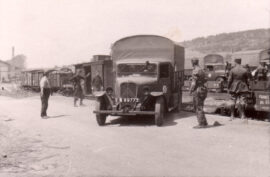
12 French Telegraph Apparatus ECTM, 1907
Fotogalerie


Beginning of the nineteenth century proceeded in the spirit of the inventions that started new chapter of the long-distance communication. Invention of electromagnetism, electricity and electrochemical sources as well as the inventions of Ampér, Schilling, Weber and Gauss moved the development towards the first telegraph apparatus designed by American Samuel Morse in 1873. His telegraph recorded signs on a moving strip of paper by means of a cutter controlled by electromagnet responding to interruption of the electric current in the circuit. The signs represented a chain of fullstops and dashes of which Alfred Vail and Samuel Morse elaborated Morse alphabet used till now. Since that moment, the long-distance communication undergoes rapid development. In 1844, Vail and Morse invented a telegraph key and at the same time, the first long-distance telegraph line was built between Washington and Baltimore. The first line of Austrian telegraph network started its operation on the route between Vienna and Brno in 1847. The same year, it was extended via Olomouc to Prague with the terminal on Masaryk’s railway station.
The most important turn in the history of the long-distance communication was made by the experiments of Italian radio-technician, amateur Guglielmo Marconi and Russian teacher of physics Alexander Stepanovich Popov at Mine School in Kronstadt. In 1896, Marconi demonstrated a wireless telegraphy up to the distance of 8 km to British representatives of Post Office, Army and Navy. One year later, he acquired the patent called “Wireless
Telegraphy by Means of Hertz Waves”. British HMS Yunio ship was the first war ship equipped with spark radio station in 1899. In December 1901, Marconi established the first transatlantic wireless communication by means of mechanically produced electromagnetic waves having frequency of about 15 kHz. The same year, the British used the wireless telegraphy on the battlefield of Boer War for the first time. The wireless telegraphy got great credit in the battles of Russia-Japan War (1904–1905). Armed Forces of all the world powers discovered the importance of the new “weapon” and began systematic development of telegraph troops.
Aktuálně

Pojízdné zařízení pro očistu bojové techniky TZ-74 GABRIEL

Oceňovaní spojenci - Pozemní útvary československé branné moci v bitvě o Francii očima francouzského velení

Vánoce a přelom roku v zahraniční misi na Slovensku v roce 2022









